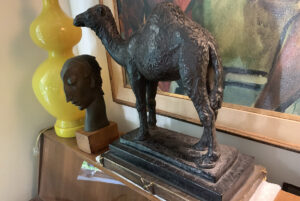 PP owns a twenty-inch plaster cast of a dromedary (Arabian) camel ‘after’ (reproduced from) a sculpture by Antoine-Louis Barye (1795-1875), the great bronze artist/animalier of the mid-19th century. Sculpture of this period, when Barye was a leading figure, told a monumental story. During this period large scale, commentative and narrative civic sculpture appealed to sentiment, sensationalism, and great power.
PP owns a twenty-inch plaster cast of a dromedary (Arabian) camel ‘after’ (reproduced from) a sculpture by Antoine-Louis Barye (1795-1875), the great bronze artist/animalier of the mid-19th century. Sculpture of this period, when Barye was a leading figure, told a monumental story. During this period large scale, commentative and narrative civic sculpture appealed to sentiment, sensationalism, and great power.
A major theme of sculpture of this period involves images of nature’s predatory violence. For example, a grand battle between a lion and a jaguar. The struggle and conquest usually depicted exotic animals portrayed with stylistic realistic accuracy.
Baryre debuted as a sculptor in the Salon of 1831
Although he never left France in his lifetime, he exhibited what became his signature theme: jungle violence. Conservative “academic” artists strictly juried Salons open to collectors with money and taste for large scale garden or civic sculpture. Here, Baryre showed his maquettes (smaller plaster casts).
One particular work, Lion Crushing a Serpent, caught the eye of the Minister of the Interior of France. He ordered it cast in 1833 for the public Tuileries Gardens, today the Musee du Louvre. This cemented Barye’s reputation, and garnered him many more monumental government and Royal Family commissions. One notable commission was the “July” Column, built 1835-1840 at the Place de la Bastille, a memorial of the fall of Charles X of France to the July Monarchy of Louis Philippe. Barye created the bronze bas-reliefs for the base of the column, notably the Gallic Rooster, in full throated crow, the National symbol of France, and of course, a lion and prey.
A monumental, seated lion was commissioned in 1846 to be placed alongside “Lion Crushing a Serpent” at the Tuileries Gardens. The Duc d ’Orleans commissioned a series of sculptures of animals pursued by various regional human hunters portrayed throughout the history of France. The Royal Family collected smaller scale “Tabletop” sculptures as well as large, monumental works for their sculpture gardens and parks, such as two monumental images of Napoleon I, mounted.
New Technological Developments in Bronze Casting
Barye created smaller sculptures with new technological developments in bronze casting in Paris. Barye seized on this opportunity to create half-scale or smaller works based on his famous monumental pieces, selling directly to the upper and middle classes in the US and Europe.
As entrepreneur, an engineer, and as artist of great ability in the reproduction of accurate animal physiology, Barye won the Grand Gold Medal for technical achievement in the Industrial Arts at the Paris Universal Exposition of 1855. On the other side of the Fair Grounds, he took a medal for Jaguar Devouring a Hare in the Fine Arts Section. This marked the beginning of the debate that still rages today: what divides mechanically produced decorative art and fine art?
In 1854 Barye was made Master of Zoological drawing at the Museum d’Histoire Naturelle, and around this period in his life that PP’s ‘Camel’ (the original) was cast in a small scale, and marketed to the middle class, willing to pay a good price for scenes of exotic animals in jungle predation for their mantelpieces, as well as smaller reproductions of grand monumental civic sculpture by Barye.
A word on the subject, the camel
Barye sculpted two of the three types of camels in his career. PP’s is an Dromedary camel, the largest of its species. A male can reach almost two and a half meters at the shoulder and live fifty years. The Bactrian camel is two humped, and domesticated in the Mongolian land steppes of central Asia. They are pack animals, known for their tolerance to cold, drought, and high altitudes, and made possible the great trade route along the Silk Road in the 16th century onwards. Barye didn’t sculpt the Bactrian Wild Camel of Northwest China, Gobi Desert, a separate species from the Bactrian Camel, as it never was domesticated. This species has double eyelashes and can survive on water saltier that seawater, or snow.
Barye, in works like PP’s camel, set the benchmark for animal and small-scale bronzes as fine art in the 19th century. If PP owned a ‘Lion Devouring Something’ there is little market for such subjects today, important works of a certain taste and time. His camel, however, is worth $4,000 as a good quality reproduction of a work by Barye.